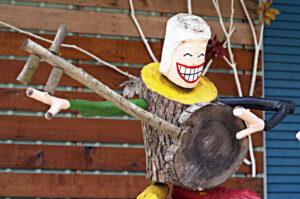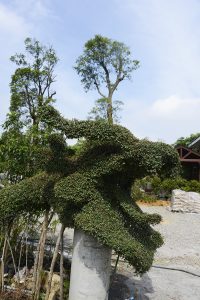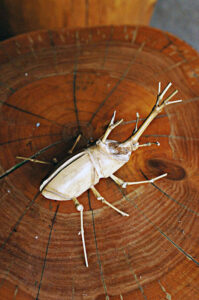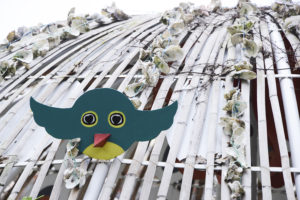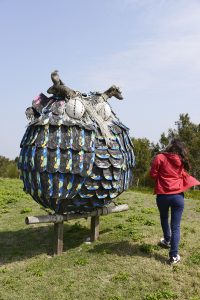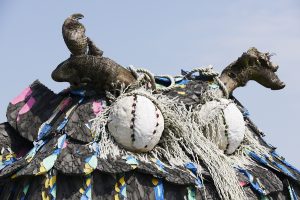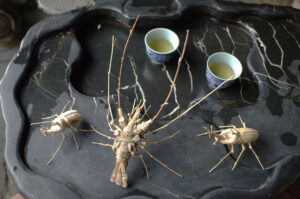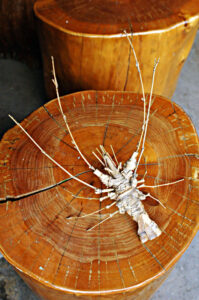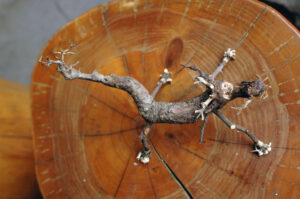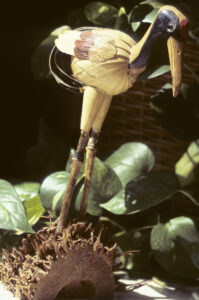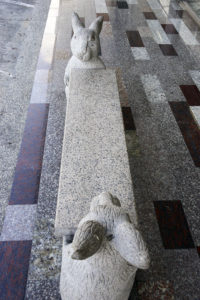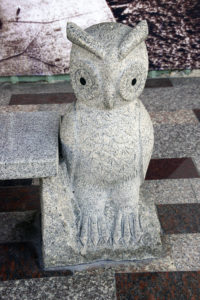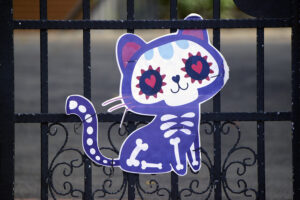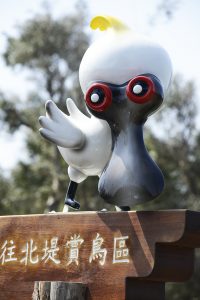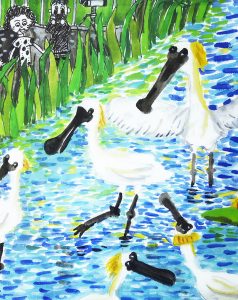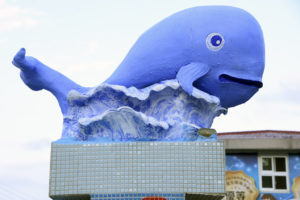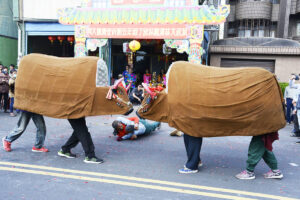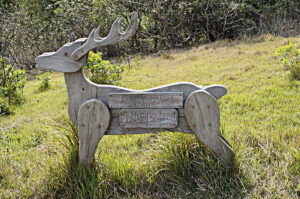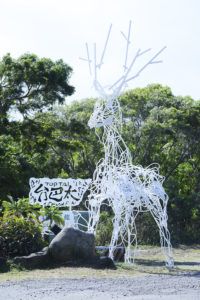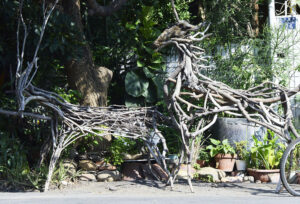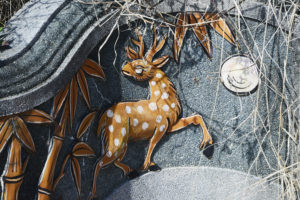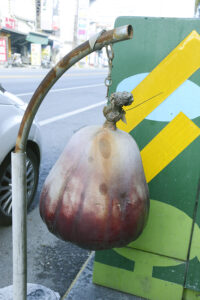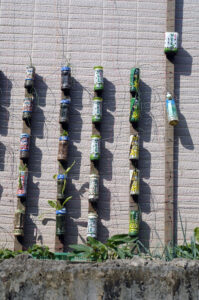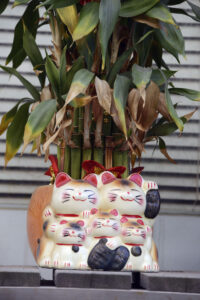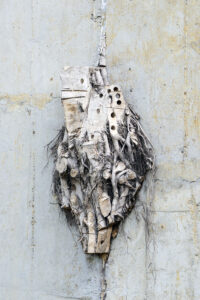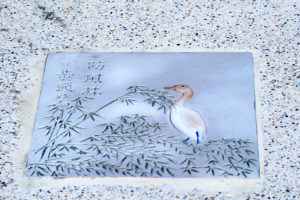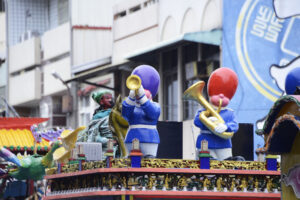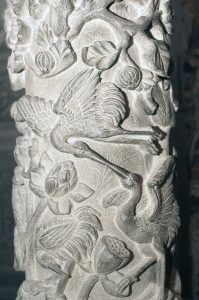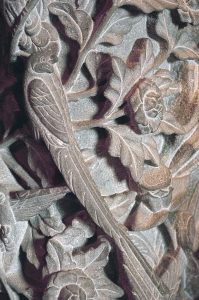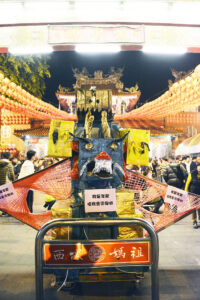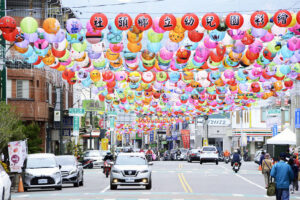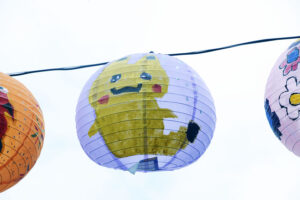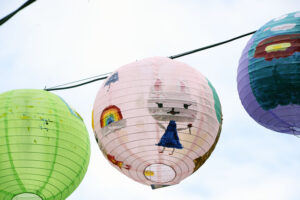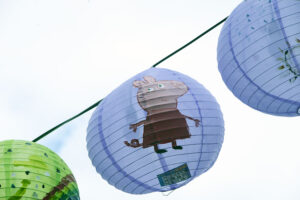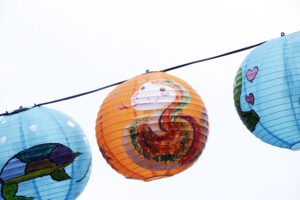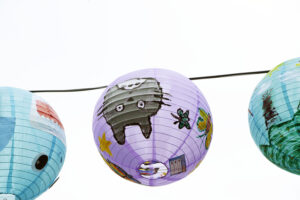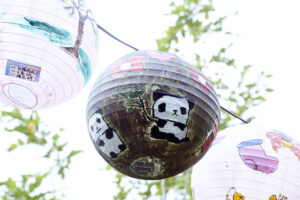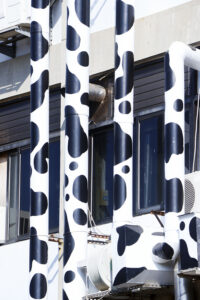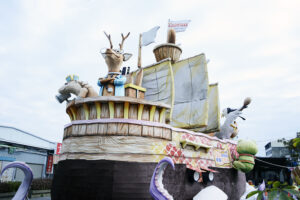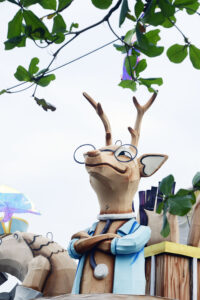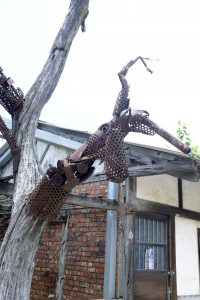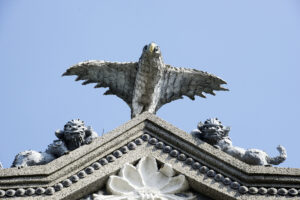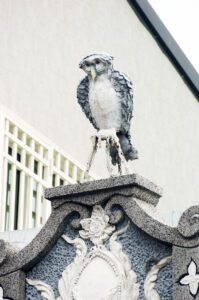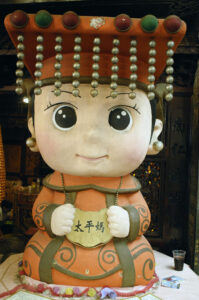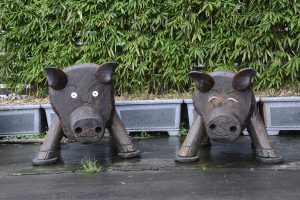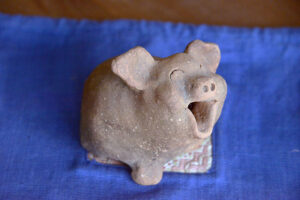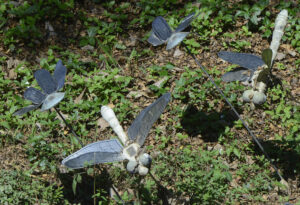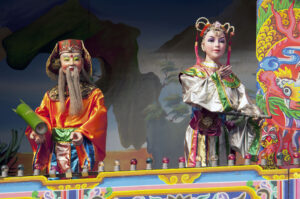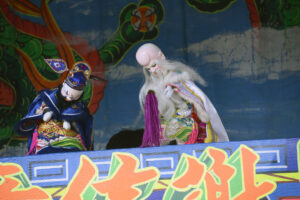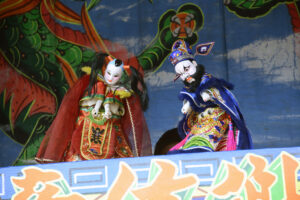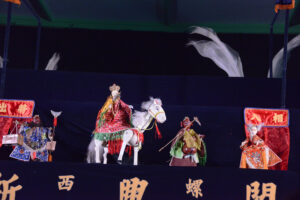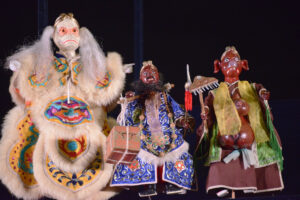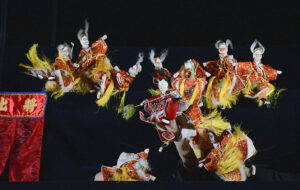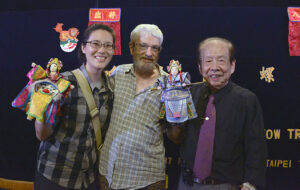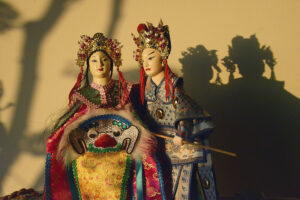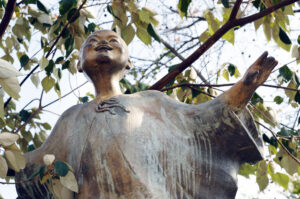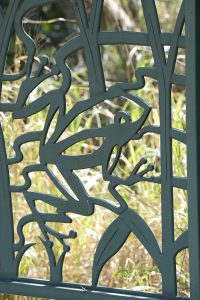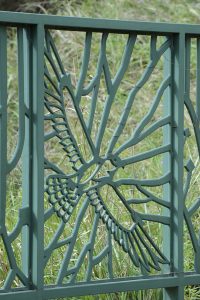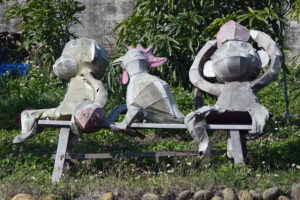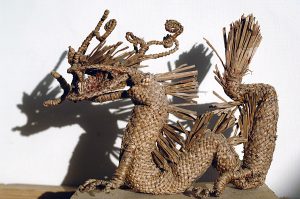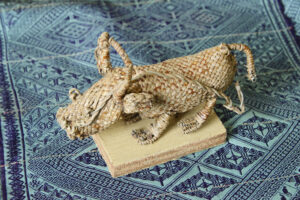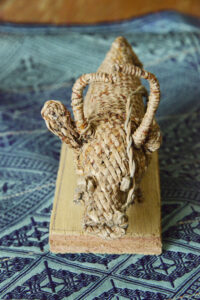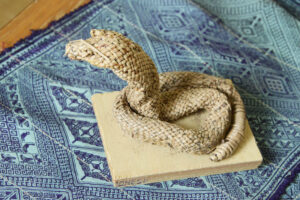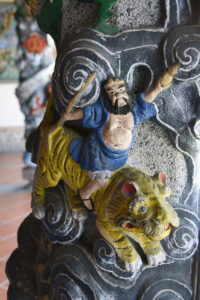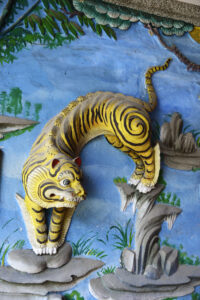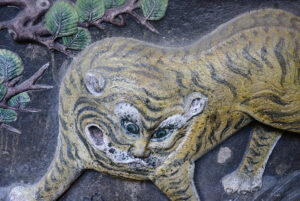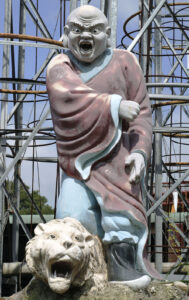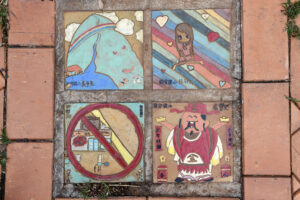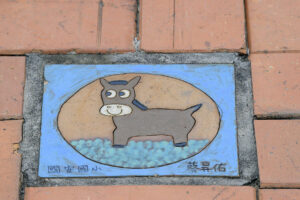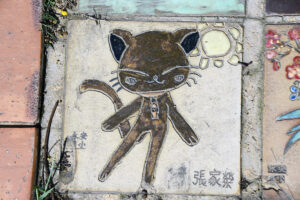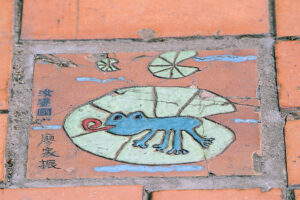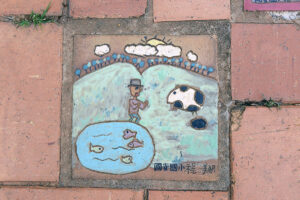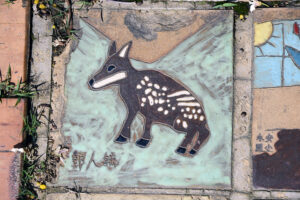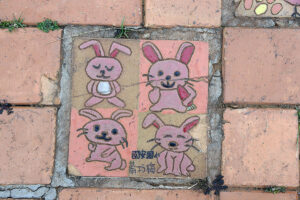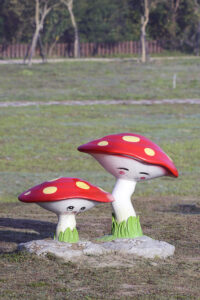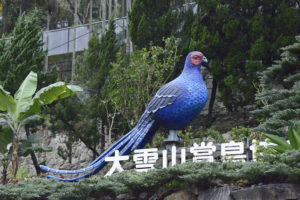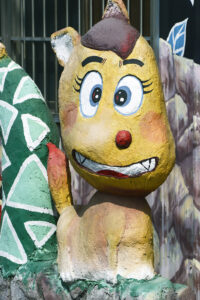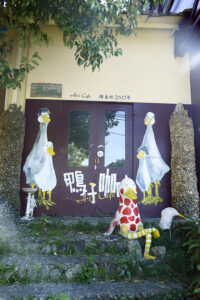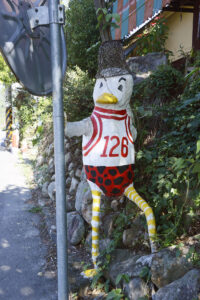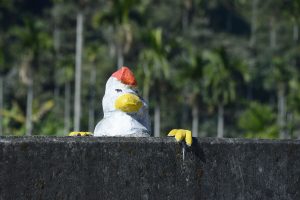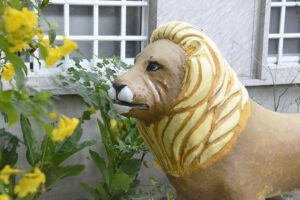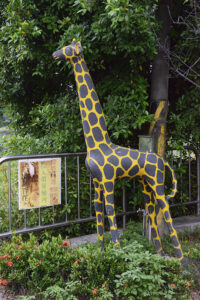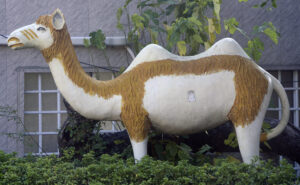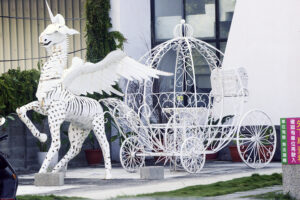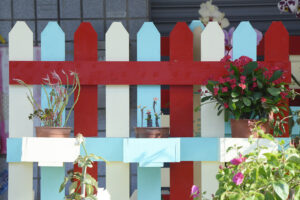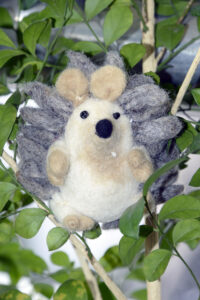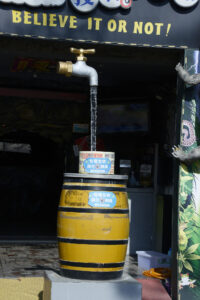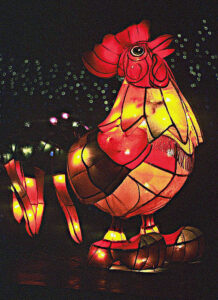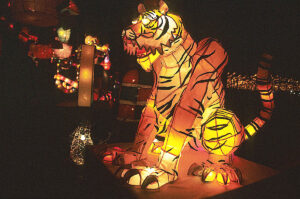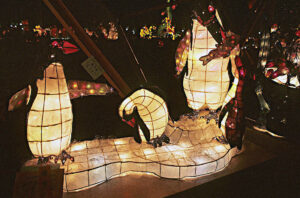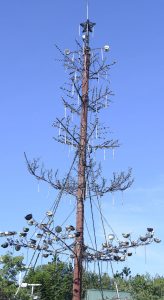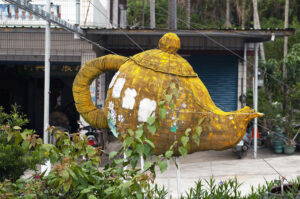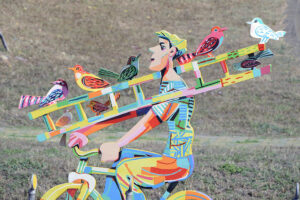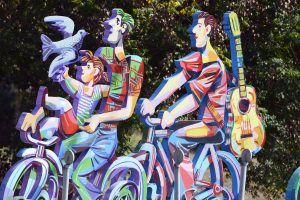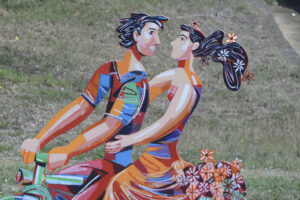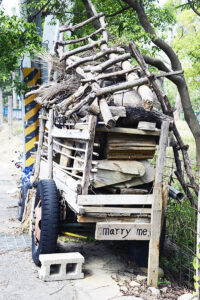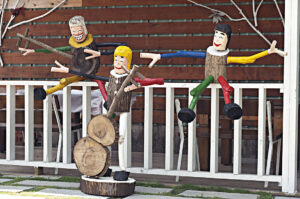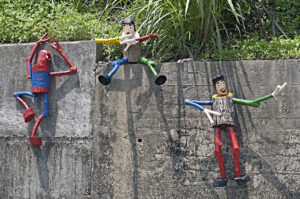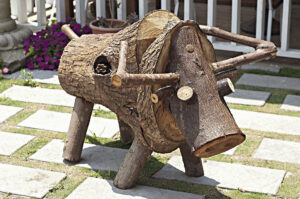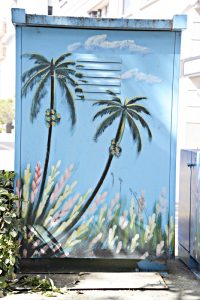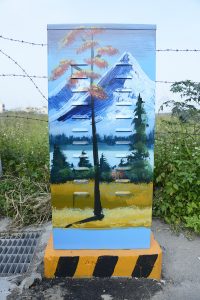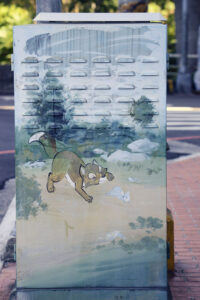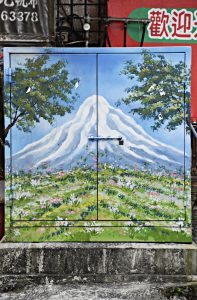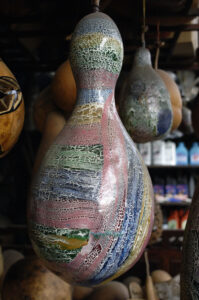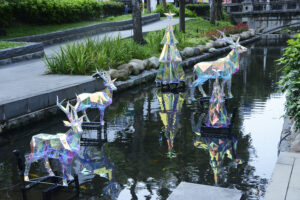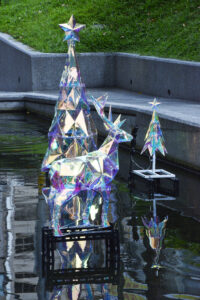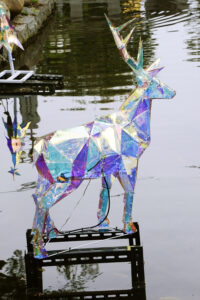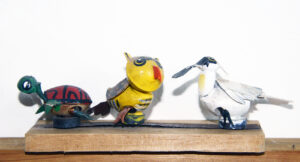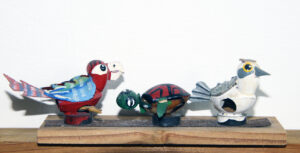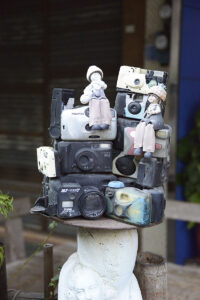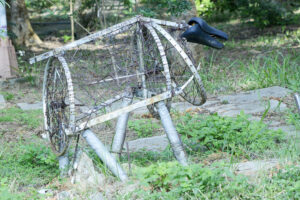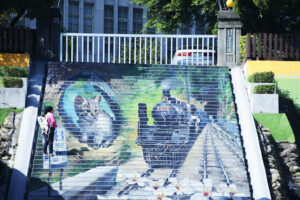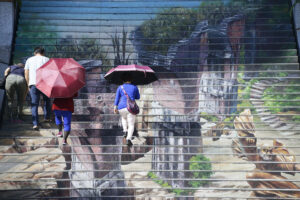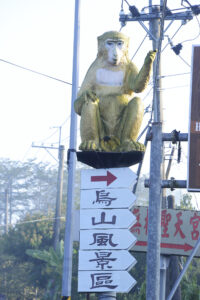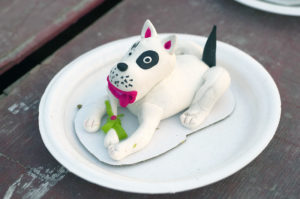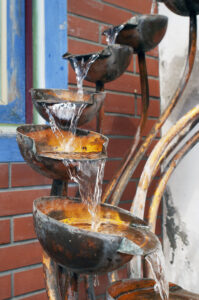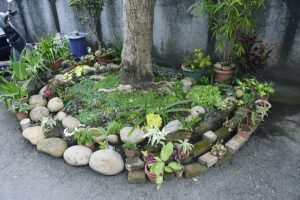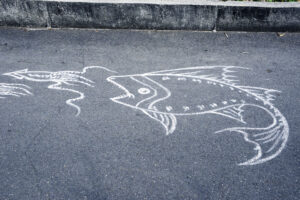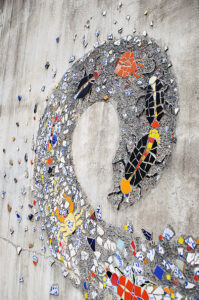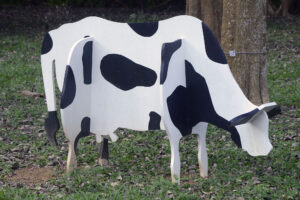Folk art of Taiwan
“Old MacDonald had a farm!” – These lanterns were exhibited at the Taiwanese Lantern Festival, celebrated in the city of Tainan during Chinese New Year 2005 (Year of the Rooster). (Photo copyright © by Kaj Halberg)
Guitarist, made from joined pieces of wood, exhibited near the town of Shenghsing. (Photo copyright © by Kaj Halberg)
This hedge near Sanyi has been trimmed to form a dragon’s head. (Photo copyright © by Kaj Halberg)
Beetle, made from bamboo branches, Dongshih, near Taichung. (Photo copyright © by Kaj Halberg)
Generally, the Taiwanese are a delightful and friendly people, who love simple things. This fact is obvious in the everyday picture through the rich and flourishing folk art, which adorns house gables, embankments along roads, and innumerable other places.
Other examples of Taiwanese art may be seen in the ubiquitous Daoist temples, which are adorned with countless sculptures, carvings, reliefs, wall paintings, and paper lanterns, depicting Chinese mythology, gods, dragons, Feng-Huang (often erroneously called ‘Chinese Phoenix’), tigers, lions etc. This artwork can be studied on the pages Religion: Daoism in Taiwan, and Culture: Lamps and lights.
Pictures, depicting Taiwanese wall paintings, are shown on a separate page: Culture: Wall paintings, and pictures, depicting artwork created by the indigenous peoples of Taiwan, are shown on the page Culture: Tribal art of Taiwan.
Aogu is a marvellous wetland north of the town of Dongshih, south-western Taiwan. In this area, various artwork has been exhibited.
Incidentally, many birds from this wetland are presented on the page Animals – Birds: Birds in Taiwan.
Exhibition ‘hall’ in Aogu Village, made from split bamboo stems, which have been adorned with oyster shells and an image of some kind of bird. (Photo copyright © by Kaj Halberg)
This ‘owl’ is made from old flip-flops, tennis balls, and rope. (Photos copyright © by Kaj Halberg)
Bird, made from bits of wood. (Photo copyright © by Kaj Halberg)
As bamboo is an extremely common plant in Taiwan, it is only natural that bamboo items often occur in local folk art.
Folk art, Dongshih, near Taichung: A lobster and two beetles, made from bamboo branches, shown on a traditional tea tray, and a dragon, made from a tree root and bits of bamboo. (Photos copyright © by Kaj Halberg)
The red-crowned crane (Grus japonensis), also called Japanese or Manchurian crane, breeds in large reedbeds in Manchuria, Inner Mongolia, and south-eastern Siberia, and a small population is also found on the island of Hokkaido, Japan. Despite the fact that this crane is a very rare visitor to Taiwan, it is commonly depicted as ornamentation in Daoist temples.
Red-crowned crane, made from bamboo. (Photo copyright © by Kaj Halberg)
This rusted sculpture, consisting of various metal parts, was observed in Taichung. (Photo copyright © by Kaj Halberg)
Erosion from sea and wind has shaped the soft Daliao Sandstone rocks in Yeliou Geopark, northern Taiwan, creating fantastic formations, including gigantic ‘mushrooms’. Many of these rocks are shown on the page Nature: Nature’s artwork.
This kitschy puppet, exhibited in Yeliou Geopark, depicts a ‘mushroom’ rock. (Photo copyright © by Kaj Halberg)
Stone benches with sculptures, depicting rabbits (top) and an owl, near Puli. (Photos copyright © by Kaj Halberg)
During Halloween, this image of a cat was placed on the entrance gate to a highschool in Taichung. This Catholic festival is described on the page Religion: Christianity. (Photo copyright © by Kaj Halberg)
The threatened black-faced spoonbill (Platalea minor) breeds on islets off the west coast of Korea, on offshore islets in Liaoning Province in China, and since 2006 also a few pairs in the Khanka Lake in south-eastern Ussuriland. (Source: Birdlife International)
From an estimated number as high as 10,000, the population plummeted to a low of 288 individuals in 1988. Since then, conservation efforts have caused the population to increase to about 7,000 individuals in 2024. Taiwan is the most important wintering area for this species with a total of about 4,000 birds.
Naturally, this iconic bird is lavishly represented in Taiwanese folk art. Some examples are shown below.
Sculpture, Aogu Wetlands, near Dongshih, south-western Taiwan. (Photo copyright © by Kaj Halberg)
During the Tainan Lantern Festival in 2005 (described elsewhere on this page), this paper lantern depicts a black-faced spoonbill.
This drawing was made by a school child. (Photo copyright © by Kaj Halberg)
Kitschy sculpture, depicting a whale, Longdong, north-eastern Taiwan. (Photo copyright © by Kaj Halberg)
During the Daoist festival Tzuoh Jiaw, held in the village of Dalinpo near Kaohshiung, local gods are worshipped to prevent bad events. Other events, including pranks, also take place during this festival.
Other Daoist festivals are described on the page Religion: Daoism in Taiwan.
During Tzuoh Jiaw, four men are performing a ‘bullfight’, while two other men simulate a fight. (Photo copyright © by Kaj Halberg)
In Taiwan, the sika deer (Cervus nippon) was almost exterminated due to excessive hunting, but has now been re-introduced in several places. Occasionally, this deer is displayed in Taiwanese folk art.
This signpost in Sheding Nature Park, Kenting National Park, is shaped as a sika deer. The text says: “Keep walking! Approaching to exit!” (Photo copyright © by Kaj Halberg)
This kitschy metal sculpture, depicting a sika deer, acts as an eye-catcher for a hotel in Sheding Nature Park. (Photo copyright © by Kaj Halberg)
Sika deer, made from branches, Taichung. (Photo copyright © by Kaj Halberg)
This Daoist grave near Chunri, southern Taiwan, is adorned with a relief, depicting a sika deer. Many other pictures, depicting Daoist graves, are shown on the page Culture: Graves. (Photo copyright © by Kaj Halberg)
The wax apple (Syzygium samarangense), also called Java apple or Semarang rose-apple, is a tropical tree of the myrtle family (Myrtaceae), which may reach a height of 12 m. Its place of origin is probably the Malay Peninsula and the Greater Sunda Islands, but it was introduced at an early stage to many other areas in Asia, and today it is widely cultivated in the tropics for its delicious fruits.
Huge sculpture in the town of Fangliao, depicting a wax apple. (Photo copyright © by Kaj Halberg)
Metal cans, recycled as flower-pots, hanging on a house wall, Taichung. (Photo copyright © by Kaj Halberg)
Flowerpot, depicting five happy cats, Taichung. (Photo copyright © by Kaj Halberg)
A fig tree had sprouted in a crack in this concrete wall along a street in Taichung. It was cut down, but some roots were still remaining, and holes were drilled into the wood, creating a small piece of art. The holes were possibly provided as breeding places for solitary bees or other insects. (Photo copyright © by Kaj Halberg)
These tiles, exhibited in Taichung (top), and in a park near the Lanyan River, north-eastern Taiwan, depict cattle egrets (Bubulcus ibis). This bird is described on the pages Animals – Birds: Birds in Taiwan, and Birds in Africa. (Photos copyright © by Kaj Halberg)
These ‘musicians’ were observed during a Daoist procession in Shingang. (Photo copyright © by Kaj Halberg)
Qingshui, known locally as Zushi-Gong, is the principal god worshipped in Qingshui Zushi Miao, a Daoist temple in the town of Sanxia, northern Taiwan. This temple is popularly known as the ‘Bird Temple’, due to the numerous depictions of birds on walls and columns. No less than 106 different bird species have been identified here, including six endemics.
The red-crowned crane (Grus japonensis), also called Japanese or Manchurian crane, breeds in large reedbeds in Manchuria, Inner Mongolia, and south-eastern Siberia, and a small population is also found on the island of Hokkaido, Japan. This species is commonly depicted in Far East artwork.
Column in the Zushi Temple with carvings, depicting red-crowned cranes and lotus flowers (Nelumbo nucifera). (Photo copyright © by Kaj Halberg)
This carving undoubtedly depicts a species of scops owl (Otus). (Photo copyright © by Kaj Halberg)
Carving, depicting a Taiwan blue magpie (Urocissa caerula). This marvellous bird is described on the page Animals – Birds: Birds in Taiwan. (Photo copyright © by Kaj Halberg)
This owl-like monster, exhibited in front of the Fushing Temple in Xiluo, carries a sign which says: ‘I am an eared animal. If you touch me, you will burn your skin.’ – This monster is killed symbolically during Chinese New Year’s Eve by igniting thousands of firecrackers around it. (Photo copyright © by Kaj Halberg)
Paper lanterns with motives, painted by children, Shetou, between Changhua and Chiayi. (Photos copyright © by Kaj Halberg)
Decorated ventilation pipes, Tunghai University Park, Taichung. (Photo copyright © by Kaj Halberg)
This ‘ship’, exhibited in Shetou, between Changhua and Chiayi, is manned by various animals. All figures are made from wire, cloth, and paper. (Photo copyright © by Kaj Halberg)
This deer may be the captain on the ship. (Photo copyright © by Kaj Halberg)
Pirate fish. (Photo copyright © by Kaj Halberg)
A black-faced spoonbill, holding a spoon (!), and a frog, blowing a horn. The spoonbill is described above. (Photo copyright © by Kaj Halberg)
This dead tree in the village of Chingliao, near Chiayi, has been ‘adorned’ with rusted metal parts. (Photo copyright © by Kaj Halberg)
These sculptures on a house roof in Xiluo depict owls and lions. (Photos copyright © by Kaj Halberg)
Kitschy image, depicting the Daoist Mother Goddess Mazu, Fushing Temple, Xiluo. (Photo copyright © by Kaj Halberg)
Pork is a very popular food item in Taiwan, so, naturally, pigs abound in Taiwanese folk art. Three examples are shown below.
Pigs, made from a tree trunk and branches, Puli. (Photo copyright © by Kaj Halberg)
Happy pig, made of clay. (Photo copyright © by Kaj Halberg)
Pig, carved in stone, Tunghai University Park, Taichung. (Photo copyright © by Kaj Halberg)
Pig’s face, made from concrete, pebbles, and a small flower pot, near Sanyi. (Photo copyright © by Kaj Halberg)
Dragonflies, made from wood and metal, Taichung. (Photos copyright © by Kaj Halberg)
Taiwanese marionette puppet show is a type of opera, in which the performance is done through cloth puppets. These puppets originated in the 17th Century in the Chinese Fujian Province. From this province, many people emigrated to Taiwan, where marionette puppet show soon became a popular art form.
Head, hands, and feet are made of carved wood, while the body and limbs consist of cloth. During the performance, a person makes the puppet move, using his gloved hand inside the puppet. In the old days, the puppets resembled sacks, hence the name 布袋戲 (bu dai xi), which literally means ‘cloth bag opera’. (Source: en.wikipedia.org/wiki/Glove_puppetry)
Traditional marionette puppet show, Jiading, near Kaoshiung (top), and at the Shueisian Temple, between Beigang and Shingang. (Photos copyright © by Kaj Halberg)
The Pilgrimage to the West is a mythological novel by Wu Cheng-en (1500-1582), in which a monk, Xuan-zang, travels to western China with his three disciples, Sun Wu-kong (‘Monkey’), who is armed with a magic stick, Zhu Ba-jie (‘Pig’), who is armed with a rake-like weapon, and Sha Wu-jing, who is responsible for the luggage, transported on a horse.
These puppets, depicting Xuan-zang (the monk), Sun Wu-kong (‘Monkey’), Zhu Ba-jie (‘Pig’), and Sha Wu-jing (the servant), were photographed during a marionette performance by the Hsin Shing-Kuo Puppet Show, taking place in the town of Huwei, western Taiwan. (Photos copyright © by Kaj Halberg)
This picture shows a scene from The Pilgrimage to the West, in which Monkey, assisted by a Heavenly Goddess, manages to kill a demon, who has abducted the monk. (Photo copyright © by Kaj Halberg)
At the same performance, Judy’s niece Guo-chin and I won these fine puppets in a lottery. In the upper picture, we are posing together with the 86-year-old grandson of the founder of Hsin Shing-Kuo Puppet Show. (Photos copyright © by Kaj Halberg)
Sculpture, depicting a happy nun, Sanyi. (Photo copyright © by Kaj Halberg)
This iron fence, surrounding a park in Taichung, is adorned with images of a frog (top) and an eagle. (Photos copyright © by Kaj Halberg)
These balloon-like puppets, depicting two monkeys and a chicken, have become faded by sunshine. They were displayed in a garden in Taichung. (Photo copyright © by Kaj Halberg)
Judy got acquainted with an elderly lady, who produced various animals from grass, which was woven around metal wires. Three examples are shown below.
In Chinese mythology, the dragon is a symbol of power, strength, and good luck. Its role in Daoism is described on the page Religion: Daoism in Taiwan. (Photo copyright © by Kaj Halberg)
Water buffalo. (Photos copyright © by Kaj Halberg)
Snake. (Photo copyright © by Kaj Halberg)
Although neither the lion nor the tiger have ever lived in Taiwan, they occur abundantly in Daoist temples as mythological creatures, often in the form of guardians.
Lion sculptures are also often placed as protectors on Daoist graves. Several examples are shown on the page Culture: Graves.
The presence of the tiger in Daoist temples is more easily explained than the presence of the lion. Daoism was brought to Taiwan from China, where the tiger was once quite common. In Chinese mythology, the tiger is the ruler of all animals, representing the masculine forces in nature. Traditionally, it is also regarded as one of the four super-intelligent creatures, the others being the dragon, the feng-huang (erroneously called ‘Chinese Phoenix’), and the tortoise.
These reliefs in the Daoist Qingshuiyan (‘Clear Water Rock’) Temple, near Tianzhong, Bagua Shan, depict tigers, one carrying a temple guardian. (Photos copyright © by Kaj Halberg)
Relief, depicting a snarling tiger with rabbit-like front teeth, Shingang. (Photo copyright © by Kaj Halberg)
This kitschy sculpture depicts a guardian with a lion, Xinpu. (Photo copyright © by Kaj Halberg)
Metal sculptures, depicting ‘garden fairies’, Taichung. (Photo copyright © by Kaj Halberg)
The tiles in the pictures below, made by school children, are exhibited in Central Taiwan Science Park, Taichung.
Various items. (Photos copyright © by Kaj Halberg)
Happy horse. (Photo copyright © by Kaj Halberg)
Dancing cat. (Photo copyright © by Kaj Halberg)
Frog on a waterlily leaf, just about to strike at some creature with its tongue. (Photo copyright © by Kaj Halberg)
It seems that this man is eager to have a boxing match with a creature, which resembles a guinea pig, but maybe it is a black-and-white cow? (Photo copyright © by Kaj Halberg)
Hen on eggs. (Photo copyright © by Kaj Halberg)
Sika deer. This species is described elsewhere on this page. (Photo copyright © by Kaj Halberg)
Smiling rabbits. (Photo copyright © by Kaj Halberg)
‘The Laughing Buddha’ and other clay items for sale as souvenirs, Lugang. (Photo copyright © by Kaj Halberg)
Images, consisting of painted concrete, are often exhibited in Taiwan. A number of examples are shown below.
The fly amanita (Amanita muscaria) is a most striking mushroom, having a bright red cap with numerous white ‘spots’, which are in fact are remnants of a membrane that encloses the mushroom in its young stage. It is native to temperate regions of the Northern Hemisphere, but has been introduced to many places in the Southern Hemisphere.
This species has hallucinogenic properties and was formerly used as an intoxicant by indigenous peoples of Siberia and Lapland. This subject is described in depth on the page Books: Seed of Knowledge, Stones of Plenty, Chapter 3.
Sculptures, depicting fly amanitas, Nanhua Ecological Park, southern Taiwan. (Photo copyright © by Kaj Halberg)
The grey wolf (Canis lupus), or simply wolf, is widespread in Europe, Arabia, the Middle East, and northern parts of Asia, as well as in North America. About 37 subspecies are recognized, some of which may merit specific status. The total number of wolves is estimated at 300,000.
Kitschy sculptures, depicting wolves, Taichung. (Photo copyright © by Kaj Halberg)
The mikado pheasant (Syrmaticus mikado), which is endemic to Taiwan, is restricted to the highest mountain areas of the island.
This sculpture, depicting a male mikado pheasant, acts as an eye-catcher for a hotel near Dasyueshan National Forest, where this bird is present. (Photo copyright © by Kaj Halberg)
Cross-eyed dog, Taichung. (Photo copyright © by Kaj Halberg)
These images, depicting ducks, are exhibited as eye catchers at the ‘Duck Café’, near Guoxing. (Photos copyright © by Kaj Halberg)
Kitschy lion, giraffe, and camel, exhibited at a small Daoist temple, Taichung. (Photos copyright © by Kaj Halberg)
Kitschy folk art, Taichung: A hybrid between a unicorn and Pegasus, pulling a Cinderella chariot. (Photo copyright © by Kaj Halberg)
Artistic arrangement of flower pots, Taichung. (Photo copyright © by Kaj Halberg)
Hedgehog, made from felt and yarn, Taichung. (Photo copyright © by Kaj Halberg)
Kitschy garage building at the ‘Ocean Hotel’ in Budai, shaped as a fiddler crab. (Photo copyright © by Kaj Halberg)
Deception of the eyes: Water, flushing from a tap without a pipe, Lugang. (The ‘water’ is part of the sculpture!). (Photo copyright © by Kaj Halberg)
During the Taiwanese Lantern Festival, which is celebrated during the Chinese New Year, elaborate lanterns are produced in the thousands. These pictures from Tainan were taken during Chinese New Year 2005 (Year of the Rooster).
Naturally, a large number of lanterns at this festival depicted roosters, as it was celebrating the start of the Year of the Rooster. (Photo copyright © by Kaj Halberg)
This lantern depicts a tiger. (Photo copyright © by Kaj Halberg)
Weight-lifting hippo. (Photo copyright © by Kaj Halberg)
Penguins. (Photo copyright © by Kaj Halberg)
Two cats, resembling Disney’s Aristocats. (Photo copyright © by Kaj Halberg)
This sculpture in Taichung, which resembles a Christmas tree, consists of an iron scaffold, ‘adorned’ with old safety helmets, golf balls, wires with gleaming bulbs, etc. (Photos copyright © by Kaj Halberg)
Sculpture, depicting a huge tea pot, near Rueilli. (Photo copyright © by Kaj Halberg)
Painted sculptures, depicting cyclists, Taichung. (Photos copyright © by Kaj Halberg)
”Marry me!” – This rather dilapidated ‘wedding coach’ in Taichung has been reduced to a storage place for firewood and a homemade ladder. (Photo copyright © by Kaj Halberg)
These figures, made from joined pieces of wood, were exhibited near the town of Shenghsing.
Musicians. (Photo copyright © by Kaj Halberg)
Spiderman. (Photo copyright © by Kaj Halberg)
Gigantic bee. (Photo copyright © by Kaj Halberg)
Water buffalo. (Photo copyright © by Kaj Halberg)
In Taiwan, electricity meter boxes are often decorated with paintings, most of which are rather kitschy.
This painting in Taichung depicts coconut palms, which must be an unknown hybrid, as the nuts are clustered on the trunk, and not, as is usually the case, just below the fronds. (Photo copyright © by Kaj Halberg)
Another painting from Taichung, depicting a perfectly shaped mountain, with a gorgeous tree in front of it. (Photo copyright © by Kaj Halberg)
This picture shows meter boxes in the city of Huwei, Yunlin Province, adorned with tigers, painted by children. (Photo copyright © by Kaj Halberg)
This painting in Taichung, one of the more perfect of its kind, depicts a fox, hunting a mouse. (Photo copyright © by Kaj Halberg)
A perfect, cone-shaped volcano and a fancy flower park, Taichung. (Photo copyright © by Kaj Halberg)
Painted gourd, Dongshih, near Taichung. (Photo copyright © by Kaj Halberg)
These kitschy Christmas decorations, most of which consist of coloured glass, depicting Christmas trees and reindeer, have been placed in a drainage canal, Taichung. (Photos copyright © by Kaj Halberg)
This sculpture, exhibited outside an elementary school in Taichung, depicts a cat with a Taiwan barbet (Psilopogon nuchalis) on its head. This bird is described on the page Animals – Birds: Birds in Taiwan. (Photo copyright © by Kaj Halberg)
These small animals, made from metal, were acquired in the town of Lugang: Tortoise, owl, black-faced spoonbill, parrot, and an unidentied bird. Parts of the animals can move, including head, wings, and tail. The spoonbill is described elsewhere on this page. (Photos copyright © by Kaj Halberg)
This sculpture, exhibited in the town of Xingang, is made from old cameras. (Photo copyright © by Kaj Halberg)
This ‘animal’ has been made from various metal parts, including bycycle wheels, the ‘head’ from two bicycle saddles, Tunghai University Park, Taichung. (Photo copyright © by Kaj Halberg)
From a distance, this painting in Sanyi gives the impression of being a huge wall painting, but on closer inspection it turns out to be a decorated staircase. (Photos copyright © by Kaj Halberg)
Sculpture, depicting a Taiwan macaque (Macaca cyclopis), Nanhua, near Yujing, southern Taiwan. This monkey is described on the page Animals – Mammals: Monkeys and apes. (Photo copyright © by Kaj Halberg)
Artsy food: Dog made from sticky rice, Puli. (Photo copyright © by Kaj Halberg)
Alternative flower pot: Discarded rubber boots, near Meishan. (Photo copyright © by Kaj Halberg)
‘Waterfall’, Lugang. (Photo copyright © by Kaj Halberg)
This tiny garden has been established around a tree at the edge of a street, Taichung. (Photo copyright © by Kaj Halberg)
Drawings with chalk on a road, depicting a dolphin, and a fish hunting a squid, Bagua Shan, near Changhua. (Photos copyright © by Kaj Halberg)
This mosaic on a wall in Yuantan Natural Ecological Park consists of broken pieces of tiles, depicting fireflies, crabs, and other creatures. (Photo copyright © by Kaj Halberg)
Cow, made from wooden boards, Tunghai University Park, Taichung. (Photo copyright © by Kaj Halberg)
(Uploaded February 2018)
(Latest update November 2024)

